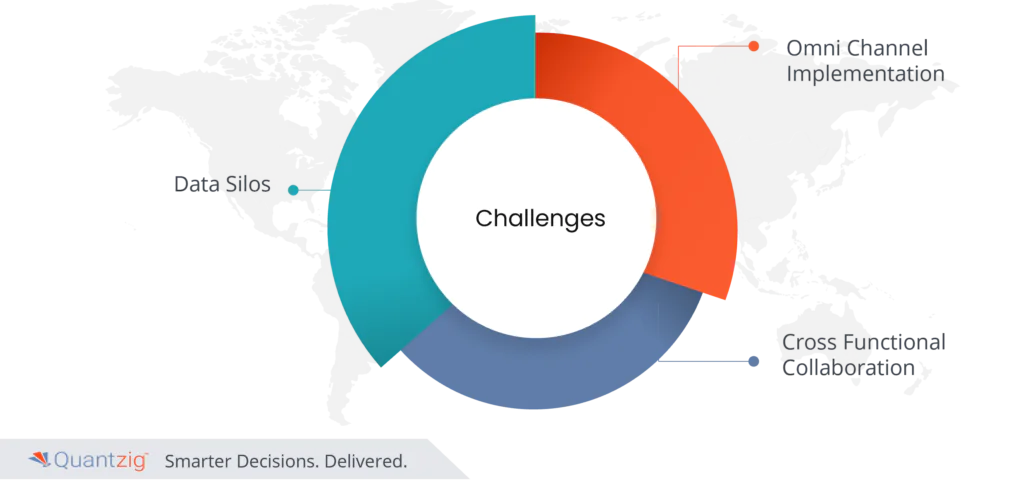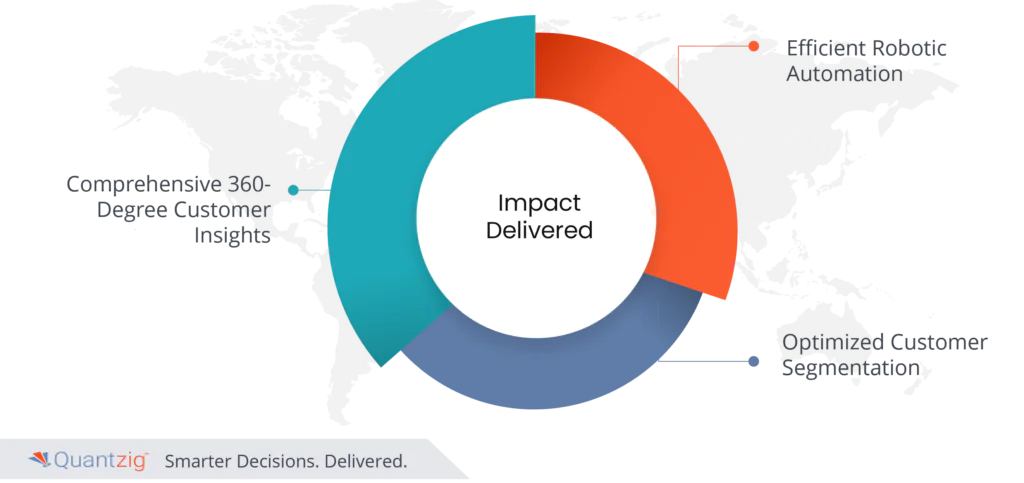Table of Contents
Introduction
In today’s dynamic corporate landscape, customer engagement is paramount for business success. The ongoing digital revolution has heightened consumer expectations for seamless, personalized interactions across all touchpoints. To meet these demands, companies are leveraging Customer Analytics 3.0, a data-driven approach tailored to the evolving market.
Central to this transformation is the Omnichannel 360° strategy, which integrates data from various sources to build comprehensive consumer profiles. This strategy enables accurate analysis of customer information, identifying profitable segments and high-value customers with specific buying habits and lifestyle preferences. It empowers companies to tailor goods and services and execute targeted marketing campaigns for enhanced customer experience management (CXM).
Traditional methods are no longer sufficient in today’s customer-centric environment. Customer Analytics 3.0 emphasizes holistic comprehension of customer behavior to foster enduring relationships. By embracing this paradigm and the Omnichannel 360° strategy, businesses can drive heightened customer engagement, foster brand loyalty, and ensure sustained growth.
Book a demo to experience the meaningful insights we derive from data through our customer analytical tools and platform capabilities. Schedule a demo today!
Request a Free DemoImportance of Customer Analytics
Understanding customer information and leveraging accurate analysis are crucial for businesses to identify profitable customers and high-value customers. By analyzing buying habits and lifestyle preferences, companies can tailor goods and services to meet customer demands effectively. This data-driven approach also enables businesses to refine marketing campaigns and enhance customer experience management (CXM), ultimately fostering lasting customer relationships and driving growth.
- In today’s rapidly changing corporate landscape, businesses must understand the intricacies of customer information to identify profitable customers and tailor goods and services accordingly. This understanding informs strategic decisions, including the development of targeted marketing campaigns aimed at high-value customers. By analyzing buying habits and lifestyle preferences with accurate analysis, companies can enhance customer experience management (CXM), fostering lasting relationships and driving sustained growth.
- Business analysts play a crucial role in refining marketing efforts through data collection and analysis. By gathering consumer behavior data, they gain insights into customer actions and preferences, enabling them to refine marketing strategies to increase sales and improve advertisement engagements. Additionally, they may utilize descriptive analytics to interpret customer satisfaction (CSAT) surveys, enhancing customer transparency and driving customer retention. This comprehensive approach, guided by business analysts, business metrics, data standardization, revenue generating activities, and customer retention, ensures that businesses can effectively navigate the evolving market landscape and achieve sustainable growth.
- Retail game changers – Omni-channel customers account for a substantial 27% of total purchases, resulting in a higher level of involvement in comparison to single-channel buyers, resulting in 7.5% more revenue for businesses. Loyalty is another aspect of this engagement; omni-channel clients have a significantly greater retention rate—by 55%. Their 30% higher lifetime value is remarkable, and it shows how important it is for firms to accommodate their preferences and behavior if they want to succeed in the long run. This necessitates thorough data collection and data standardization to enable Descriptive analytics and provide consumer behavior data insights. Utilizing business metrics derived from customer actions, firms can refine marketing efforts and optimize advertisement engagements to ultimately increase sales and drive revenue generating activities. Moreover, gathering customer satisfaction (CSAT) surveys fosters customer transparency and aids in customer retention strategies, empowering business analysts to make informed decisions.
In a nutshell, business analysts utilize consumer behavior data and customer actions to gauge customer satisfaction (CSAT) through surveys. This data collection informs descriptive analytics that aid in understanding advertisement engagements and refining marketing efforts. By standardizing data and ensuring customer transparency, companies can optimize business metrics, data standardization, driving revenue generating activities and ultimately increasing sales while fostering customer retention.
Experience the advantages firsthand by testing a customized complimentary pilot designed to address your specific capacity planning requirements. Pilot studies are non-committal in nature.
Request a Free PilotChallenges
In the fast-paced digital era, empowering customers has become a central focus for businesses seeking to thrive in an increasingly competitive landscape. As companies strive to tailor products and services to meet the diverse needs of their audience in proactive ways, social media listening tools, customer analytics software, timeline, navigating the challenges of customer empowerment becomes essential. This introduction to interdisciplinary group will explore the hurdles faced by organizations in harnessing the power of customer analytics and leveraging customer data to enhance the customer journey. It will touch upon the importance of interdisciplinary collaboration among leaders and departments, including marketing, sales, customer service, and IT, to effectively collect, organize, and analyze raw data from various sources. Additionally, proactive strategies collection, marketing tools and the utilization of customer analytics tools, CRM systems product or service, and third-party sources will be highlighted as crucial skills for customer experience professionals and customer’s lifetime value. By addressing these challenges and low rating in customer empowering, businesses can unlock opportunities to better understand their customer base and drive meaningful engagement in today’s dynamic marketplace.

- Data Silos – One of the biggest obstacles to customer analytics is data silos. The quality of consumer data is compromised by these fragmented data sources, which frequently have incompatible formats and make it difficult to map customer journeys holistically. Furthermore, handling data that is so fragmented becomes difficult.
- Omni Channel Implementation – One of the biggest challenges facing organisations with limited resources is implementing Omni Channel strategy. These projects require a large investment in technology as well as the know-how to successfully negotiate the challenging terrain of customer data analysis and interpretation. They are labour- and capital-intensive projects. Proficiency in data analytics is necessary, hence exacerbating the expenses.
- Cross Functional Collaboration – Key components of a successful Omnichannel customer analytics strategy are promoting co-creation and strengthening cross-functional collaboration. It is a difficult task to effectively integrate different departments and promote team creativity in the dynamic company environment.
In conclusion, navigating the complexities of customer data management and leveraging insights derived from diverse sources such as demographics, purchase history, and web and social media activity, presents both challenges and opportunities for businesses. By integrating contact center interactions, secure servers, data backup, data disposal, survey responses, and data from customer data platforms (CDPs) into actionable charts and graphs, organizations can identify emerging trends and refine customer segments to target middle-income women effectively. Armed with this knowledge, businesses can make informed business decisions tailored to enhance customer interactions and satisfaction across various touchpoints. Furthermore, by leveraging quantitative and qualitative surveys, companies can engage customers at the right moment and through the right channel, mitigating churn rates and maximizing customer lifetime value. Through the strategic use of big data and insights into online behavior, personalized selling can be facilitated, fostering market segmentation and brand loyalty. Whether integrated into a CRM suite or utilized through standalone platforms, customer loyalty programs can further solidify the bond between customers and brands, ensuring long-term success in today’s dynamic marketplace.
Get started with your complimentary trial today and delve into our platform without any obligations. Explore our wide range of customized, consumption driven analytical solutions services built across the analytical maturity levels.
Start your Free TrialBenefits
In today’s competitive landscape, empowering customers emerges as a strategic imperative for businesses aiming to foster lasting relationships and drive sustainable growth. This introduction explores the myriad benefits of customer empowerment, ranging from improved customer satisfaction to enhanced brand loyalty and retention. Leveraging a diverse array of tools and techniques, including online quizzes, social media polls, and loyalty cards, major vendors and publishers can gather valuable zero-party data directly from customers. This rich data, combined with contextual marketing insights and customer service metrics such as CSAT and CES scores, enables businesses to tailor their offerings and support services to meet customer needs effectively. By employing social media metrics and support data, organizations can glean actionable insights into customer preferences and behaviors, guiding best practices and informing business objectives. Utilizing cutting-edge customer service software solutions like Zendesk and customer data platforms (CDPs), businesses can streamline data storage and analysis processes, ensuring data security through encryption, access controls, and regular backups. Furthermore, employing data validation tools and redundant data categorization facilitates the identification of patterns and takeaways, enabling data-driven decision-making and predictive analytics. By harnessing the power of customer data analysis and visualization, businesses can optimize operating costs while maximizing customer retention and satisfaction, ultimately achieving their strategic goals and objectives within a dynamic marketplace.
- Maximized Customer Lifetime Value – Omnichannel customer analytics 3.0 enables companies to increase the lifetime value of each customer by identifying and driving behaviors that generate better return on investment (ROI). By influencing purchasing decisions across all available channels, companies can create customized strategies that meet individual customer preferences and increase overall profitability.
- Omni Channel Activation – Activation channels and touchpoints are empowered to function instantaneously and on their own using this technique. Regardless of the channel they use, it makes it possible for a smooth and quick customer engagement process, guaranteeing that consumers receive the appropriate offers and messages at the appropriate times.
- Dynamic Intent based Action – To drive activities, this system focuses on recent consumer behaviour rather than using basic segmental knowledge. Businesses may more effectively personalise their reactions and improve the overall customer experience by knowing the precise purpose and actions of individual customers in real-time.
- Guiding Customer Journey – Not just at the final touchpoint of the transaction, but throughout the entire customer experience, is where omnichannel customer analytics 3.0 provide insights. This makes it possible for businesses to offer assistance, knowledge, and incentives at every stage of the purchasing process, leading to Informed Purchase decisions.
- AI Powered Recommendation Strategy – Businesses may scale their suggestions properly and quickly by utilising AI. They provide extremely relevant product or content recommendations, increasing conversion rates and customer happiness by analysing vast amounts of data and user behaviour.
Success Story
Client Details –
A Multinational Athleisure Company located in Germany
Challenges faced by the Client
- A major challenge faced by a recognized German Athleisure brand company with an annual sales of more than $8 billion was to increase consumer interaction and encourage recurring business through highly customised methods. Their customer base is large and diversified, therefore it became essential to have a deeper understanding of them in order to create customised strategies that would boost repeat business and foster brand loyalty. For the brand to be able to offer individualised experiences that not only satisfy but also encourage its customer base to return for future engagements, it was necessary to have a strong customer analytics solution that could provide detailed insights into customer preferences, behaviours, and purchasing patterns.
- Another Major issue client faced was poor data management. Poorly managed data prevented the brand from developing a holistic view of customer behavior that went beyond a single session or interaction. This lack of data management prevented the brand from delivering smooth, personalized customer journeys and developing data driven strategies to improve customer engagement and retention. To overcome this issue, the client had to completely overhaul their data management processes and implement advanced customer analytics solutions that can transform disparate data into actionable insight for better decision-making and better customer relationship management and long-term growth.
Solutions Offered by Quantzig
- Building a strong Customer 360 Datamart – a core repository including channel, behavioural, transactional, and demographic data – was the first step in our journey. We painstakingly integrated important customer characteristics, purchase inclinations, marketing engagement histories, and related channel behaviours into this Datamart, giving our client a complete platform to facilitate data-driven decision-making, customised customer engagement, and enduring brand loyalty.
- In order to improve our client’s comprehension of consumer behaviour, we carefully uncovered a variety of possible characteristics that could favourably or unfavourably impact purchasing decisions. This thorough attribute evaluation took into account a wide range of variables, including customer demographics, transaction histories, and marketing engagement patterns. As a result, it provided insightful information about the complex dynamics influencing consumer behaviour.
- With the help of decision trees and look like modeling, we looked deeper to identify customer segments with higher purchase propensity. This analysis revealed the key attributes driving these propensity and allowed us to identify specific customer groups or segment. With this, our client was able to execute targeted strategies and personalised engagements using data-driven accuracy to nurture high-value customers along their individual journeys.
- Our Solution extended to pinpointing Pivotal Junctures within customer journeys and working together to create activation plans covering both the inner loop customer experience (Website) and the outer loop customer experience (Campaigns). By understanding these critical inflection points we were able to optimise customer interactions, improving the overall effectiveness of the brand’s online presence and campaign efforts.
Impact Delivered

- Comprehensive 360-Degree Customer Insights – Our solution gave clients access to a self-serve intelligence platform that gave them a 360-degree picture of each customer and acted as a single source of truth, making it easier to make decisions and improve customer interactions.
- Efficient Robotic Automation – Through intelligent automation, we made it easier for robots to perform next best actions with little to no human input, increasing productivity and customer involvement.
- Optimized Customer Segmentation – In addition, clients were able to identify high-return customer types and successfully migrate value from other segments into these high-return groups, improving strategies and increasing ROI.
Conclusion
Omnichannel 360° integration within customer analytics 3.0 is a game-changer in customer engagement strategy. It allows businesses to adapt to the changing consumer landscape with speed, personalization and data-based accuracy. The advantages are clear: increased lifetime value, immediate omnichannel engagement, dynamic intent based actions and AI-powered recommendations. By adopting these innovations, businesses can set themselves up for success in an era of customer-centricity, building loyalty and long-term success.



